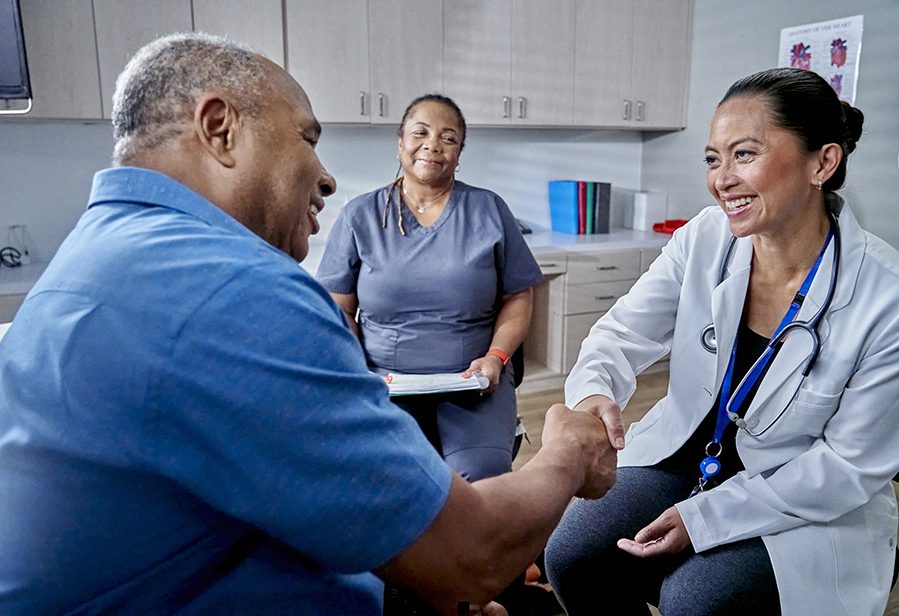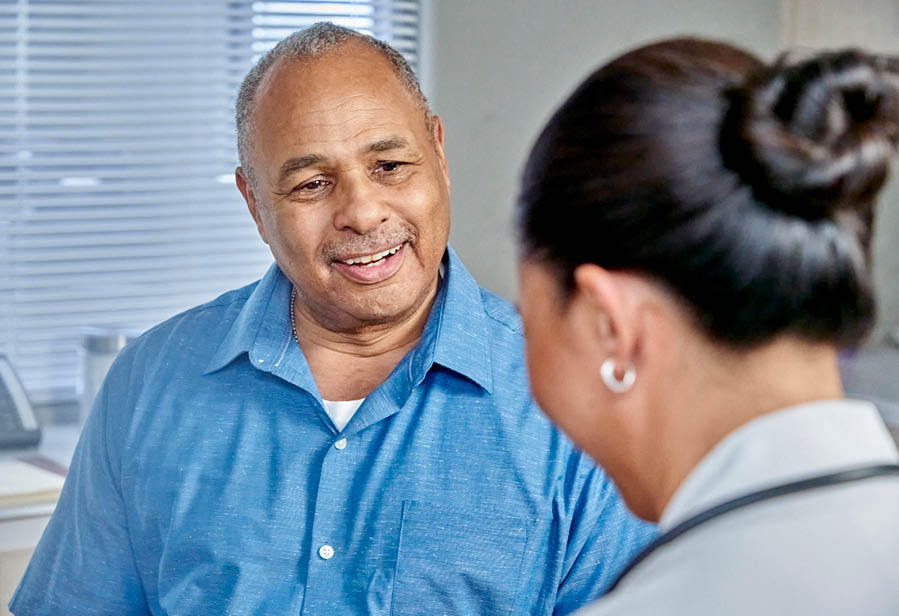Osteoporosis means “porous bone” and is a condition in which bones lose their density and become brittle and weak. Not only does this increase the risk of broken bones from falls and accidents, but also even coughing, sudden movements or leaning over can result in fractures in advanced cases.

What are the symptoms of osteoporosis?
Though osteoporosis shows no outward symptoms in its early stages, symptoms may materialize as it progresses.
These include:
- Posture becoming stooped
- Lower back pain
- A loss of an inch or more in height
- Easily broken bones
While your bones continuously break down and replace old materials to maintain their strength, osteoporosis occurs when the creation of new bone doesn’t keep up with what’s being broken down. Unfortunately, age plays a role, along with some other factors.
What are the causes of osteoporosis?
While bone growth slows naturally as we age, early-age bone growth, hormone balance, lifestyle, genetics and nutrition can all affect your likelihood for osteoporosis later in life.
For instance, the bone renewal process starts to slow in your 20s and peaks at around the age of 30. Those with less substantial bone growth when younger are more likely to experience osteoporosis later in life. This may be due to a lack of vitamin D, calcium and other minerals necessary for bone growth, or it may be affected by ethnicity, frame size or gender.
Regardless of the cause, a lack of early-age bone growth means less “bone in the bank” later in life so that any bone loss becomes substantial.
Even those who do experience healthy bone growth in their youth may not get the nutrition they need later in life, and there are other risk factors that can lead to porous, brittle bones, despite previously good ones.
What are the risk factors?
While factors such as age, gender, size, race and family history can’t be controlled, there are other risk factors that can be.
These include:
Inactivity
You may already be aware of the effects of a sedentary lifestyle on your overall health, which also has a profound effect on your bone health. That’s because your bones are like your muscles in that they need the “work” of weight-bearing exercise to stay strong and dense.
To maintain bone mass, use strengthening exercises, such as weight or stretch band training, walking, dancing or sit-to-stands. To perform sit-to-stands, use a chair behind you with your feet hip-width apart, and slowly sit before pushing through your heels back to a standing position.
Another healthy exercise is gardening, which adds vitamin D-boosting sunlight, fresh air and, possibly, fresh veggies for you, as well; or you can join a gym or exercise group, which adds a social element to your activities.
Alcohol or tobacco use
Not only can alcohol and/or tobacco use destroy many facets of your health, both can advance the onset of osteoporosis.
For instance, smoking not only introduces toxins into your system, but nicotine also blocks the uptake of calcium and vitamin D to bone cells. Alcohol use can also increase calcium loss in bones, not to mention that too many drinks can cause accidents and falls.
Plus, both can affect your hormone balance, which is another factor in maintaining bone density.
Hormone balance
Your bones need the help of estrogen in women, testosterone in men and balanced hormones in both sexes to remain healthy.
For instance, an overactive thyroid can release too much parathyroid hormone into your system, which results in calcium loss through urination. Women who experience menopause and men experiencing age-related testosterone decline are also at risk for accelerated bone loss, though both are due to estrogen’s role in keeping bones dense and pliable. Since much estrogen starts as testosterone in men before being converted to estrogen, osteoporosis can also affect men with low testosterone.
But while you may have only limited control over age-related hormone decline and menopause, you can exercise, avoid stress, avoid endocrine disruptors and maintain a healthy diet a for better hormone balance.
Nutrition
Not only do your bones need calcium and vitamin D to stay strong, but severe calorie restriction and being underweight can also cause osteoporosis. And not only does malnutrition mean not enough bone-friendly nutrients, but it also causes low estrogen, which is why eating disorders are commonly associated with low bone density.
The bottom line? Enjoy a healthy whole foods diet that doesn’t skimp on the leafy greens; fresh, oily fish; or protein, since that’s what you need for bone-healthy nutrition and hormone balance. It’s also not a bad idea to supplement with calcium, vitamin D, vitamin K, and other vitamins, minerals and proteins necessary for strong bones if you’re not getting enough.
Medications and Medical Conditions
Medications, such as steroid treatments or medications for seizures, gastric reflux, cancer, and transplant rejection, can negatively effect bone density. Medical conditions, particularly those affecting hormone balance, can also play a role in advancing osteoporosis. These include rheumatoid arthritis; cancer; kidney or liver disease; inflammatory bowel diseases; and celiac disease.
Remember, too, that Caucasian and Asian women are also at greater risk of osteoporosis than those of African or Hispanic descent; and being of slight build also increases the risk.
How is osteoporosis diagnosed?
To check for osteoporosis, your doctor may perform a determining test even before you experience problems. To do this, small amounts of radiation are used to determine bone density in your spine, hips and wrist areas, which is known of as a bone mineral density (BMD) test, or dual-energy x-ray absorptiometry (DEXA or DXA) scan.
This should be done for all women over age 65 and men over 70, or earlier for women and men who are at higher risk.
What are the treatment options?
As with many conditions, the best treatment options for osteoporosis start with prevention. This means maintaining a healthy diet and active lifestyle that includes weight-bearing exercise. You also need to ensure you take in enough bone-friendly nutrients, and balance exercises to prevent falls are also recommended.
There are also several classes of medications your doctor may prescribe for you, which may include hormone therapy medications, anti-absorptive drugs to prevent the reabsorption of bone tissue, anabolic agents, and a category of drugs called “biologics” that are often used when other treatments fail.
Can you prevent osteoporosis?
Prevention is the best treatment for osteoporosis, and in some cases, it may even reverse some bone loss. This means maintaining a diet of foods high in calcium and vitamin D, such as canned sardines, dairy and fresh wild salmon, and you can also bolster your vitamin D levels with time outdoors in the sunlight.
Along with this, you need to avoid or limit your use of alcohol and caffeine, both of which can accelerate bone loss.
Regular weight-bearing exercise is also important, along with balance exercises to prevent falls, and will help keep you happy, healthy and independent well into your senior years. This can be anything from joining a gym to using stretch bands in your home or taking aerobics classes, walking or running. Practicing yoga can also help improve your flexibility and equilibrium while easing stress to maintain healthy hormone balance.
How can you live with osteoporosis?
Upon diagnosis of osteoporosis, it’s important that you continue (or begin) living a healthy lifestyle with enough weight-bearing exercise, calcium and vitamin D each day. You should also keep alcoholic drinks down to no more than one per day, and if you smoke, just quit, OK? There are support groups and other quitting aids you can use to rid yourself of this habit, which is one of the worst—and least social—ways to destroy your health.
We know you can do it!
Also, keep your floors free of clutter, maintain bright lighting, avoid having slippery floors and use grab bars, such as stair rails, whenever possible to prevent falls and accidents indoors. You should use outdoor lighting or a bright flashlight outside the home when it’s dark, and walkways and other areas of the yard should be kept clutter-free. Be sure to wear good, supportive shoes with grippy soles, and if possible, keep things “hands-free,” with a backpack or shoulder bag.
Above all, use good sense and avoid anything that increases your chance of an accident.
When should you contact a care provider?
If you have risk factors for osteoporosis, the sooner you’re diagnosed, the better. Seeing your doctor and requesting a BMD test at an early enough age can make all the difference later in life, when broken bones can be not only a painful ordeal, but also possibly life-threatening.
And of course, if you are experiencing back pain, stooped posture, loss of height or other symptoms of osteoporosis, don’t delay seeing your doctor for diagnosis and treatment.
Which questions should you ask your doctor?
If you’ve been diagnosed with osteoporosis, there are some questions you may want to ask your doctor, such as:
- What is the root cause of my condition?
- Can this be reversed and how?
- How will this affect my daily activities?
- What are all the dangers I need to be aware of?
You may have more questions than this, which is good, since you need all the information you can get. Don’t worry; there is no such thing as a stupid question, and along with being a top healthcare professional, your Intermountain physician is compassionate, patient and concerned enough to carefully answer all of them.
Why should you choose a provider at Intermountain Health?
Whether it’s early detection of osteoporosis or any other aspect requiring top-quality healthcare you need, Intermountain Health is here for you. We pride ourselves on going the extra mile in providing the safest, most state-of-the-art healthcare possible and put your needs first each and every time you visit.
At Intermountain Health, our award-winning staff are waiting to treat you with kindness, compassion and award-winning expertise, and that’s our promise to you.
*This article is for informational purposes only and is not intended to be a substitute for medical advice or diagnosis from a physician or qualified healthcare professional.





